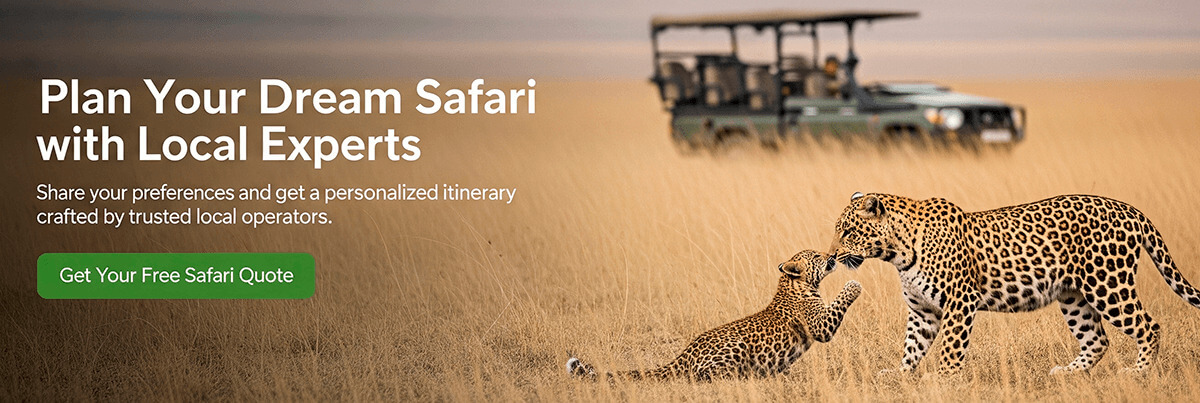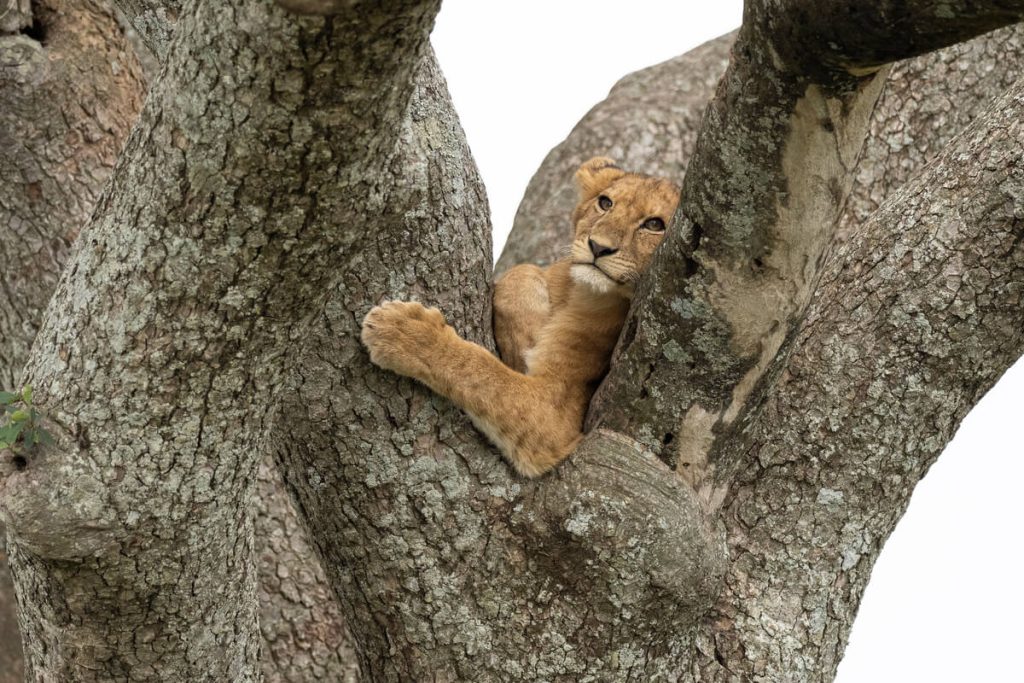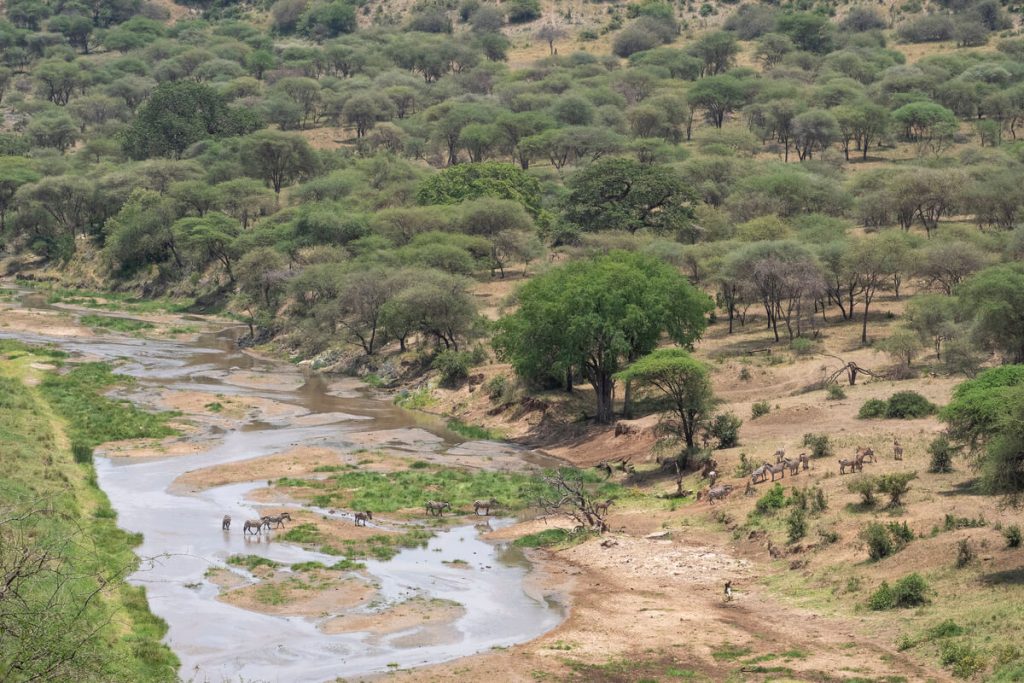A safari in Tanzania allows you to immerse yourself in the most classic scenes from African savanna documentaries. It’s about traversing endless plains of golden grass in search of fascinating mammals such as lions, rhinos, elephants, and cheetahs, all in a completely wild and untouched environment.
Tanzania is a vast country, with multiple national parks for safari adventures. Each area has its own unique features and charm. However, it’s hard to surpass the magic of a safari in Serengeti National Park.


The Symbol of Tanzanian Safaris: Serengeti National Park
Serengeti National Park is the oldest national park in Tanzania and has been a UNESCO World Heritage Site since 1981. Its natural beauty and ecological importance make the Serengeti one of the most iconic territories in Tanzania and Africa.
The Serengeti protects an area of about 13,000 km² and is surrounded by the Ngorongoro Conservation Area, which covers more than 8,200 km². This makes the endless plains of this national park a true haven where nature flows undisturbed. No human pressures. And this is a distinctive feature of safaris in the Serengeti.

How to Get to Serengeti National Park
Located in northern Tanzania, the Serengeti is most commonly accessed from the city of Arusha, approximately 320 kilometers away. There are two main ways to reach the park:
1. By Car
The drive from Arusha to the Serengeti is long, typically taking no less than seven hours. The first part of the journey is on a paved road that connects the city to the entrance of the Ngorongoro Conservation Area. Once there, it takes about three to four hours to reach the entrance of Serengeti National Park (specifically, the Naabi Hill Gate). The ride is quite uncomfortable (the perfect example of an African massage), as the track is dirt and very bumpy. But it’s also a beautiful journey.
Along the road connecting the main entrance of the Ngorongoro Conservation Area to Serengeti National Park, you can admire the magnificent and varied landscape of this conservation area: first, the jungle covering the highlands; then, the incomparable Ngorongoro Crater; and further ahead, the endless savannah. It’s also common to see the first giraffes, gazelles, zebras, or impalas walking among the Maasai villages that still exist in this territory.
This route can only be done in a 4×4, and public transport is not an option. Therefore, the only two choices are to rent a car (it’s common to rent with a driver) or book an organized safari. Organized safaris include the vehicle, guide, accommodation, and meals; and it is the easiest way to go on a safari in Tanzania. To reduce costs, a great option is to book a safari directly with a local operator. To do this, you can use this form I’ve created to connect with trusted local operators that will prepare a personalized itinerary and budget for your safari.
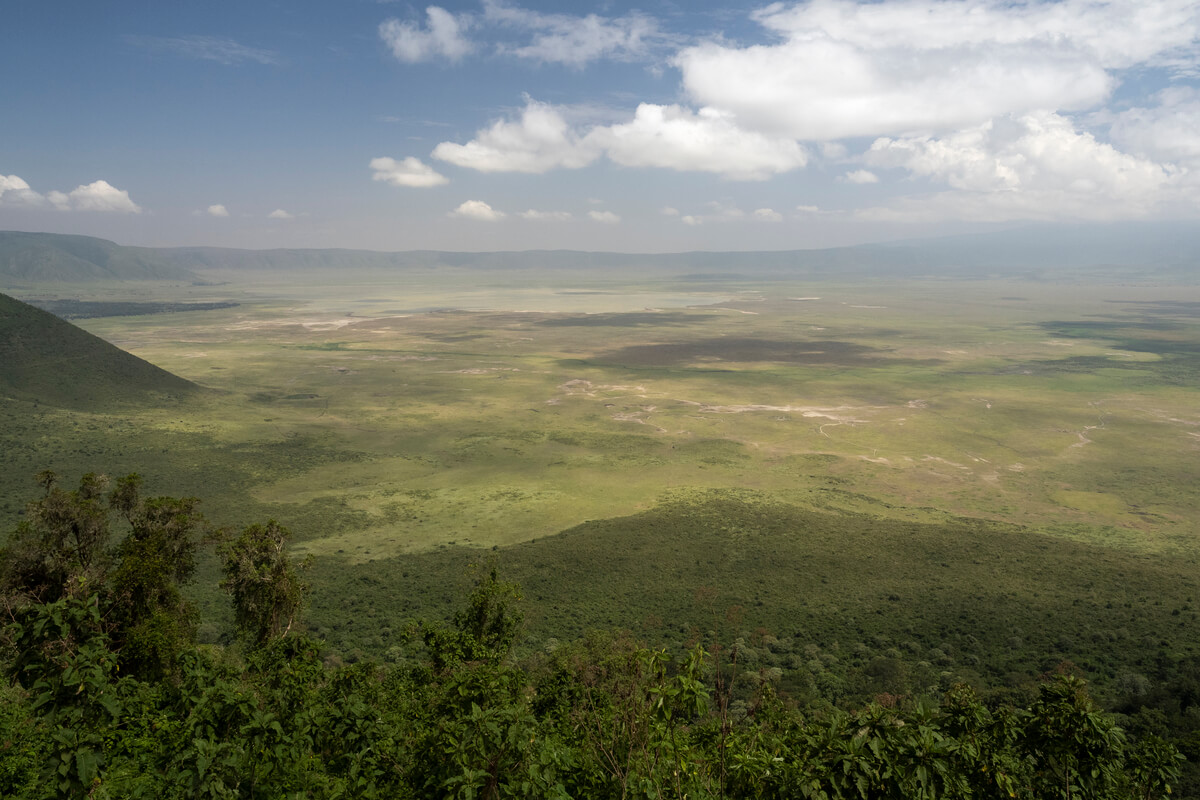


2. Get to the Serengeti by Plane
If you’re short on time and have a higher budget, flying into the Serengeti is a convenient option. Small planes land at various airstrips throughout the park, with Seronera Airstrip being the most popular. Flights from Arusha take about 45 minutes.
Best Itinerary for a Serengeti Safari
Driving to Serengeti National Park is a longer and less comfortable option, but it’s also the perfect opportunity to visit other national parks and enjoy a much more complete safari experience in Tanzania. In fact, this way the long journey to the Serengeti can be split into different stages, allowing you to go on safari in two parks that lie along the route: Tarangire National Park and Lake Manyara National Park.
The ideal itinerary for a six-day safari in northern Tanzania would be:
- Day 1: Drive from Arusha to Lake Manyara National Park, with a safari from mid-morning until late afternoon. Overnight stay in the town of Mto Wa Mbu.
- Day 2: Travel from Mto Wa Mbu to Serengeti National Park, passing through the Ngorongoro Conservation Area.
- Day 3: Full-day safari in Serengeti National Park.
- Day 4: Last morning safari in the Serengeti and transfer to the Ngorongoro Crater.
- Day 5: Safari in the Ngorongoro Crater and drive back to Mto Wa Mbu.
- Day 6: Morning safari in Tarangire National Park and return to Arusha by midday.
If you want to go on a longer safari in Tanzania, spending more time in the Serengeti is always a rewarding choice. If you’re looking to explore other areas, a great option is to head to the Lake Ndutu region (safaris here are exceptional in January and especially February) or visit Lake Natron (a region known for its dramatic landscapes, where you can also climb the Ol Doinyo Lengai volcano).
💡 Get a Free Quote for Your Trip to Tanzania with Trusted Local Operators
If you’d like to plan your trip to Tanzania with reliable local tour operators, I can help you connect with the best ones. Just fill out this quick form, and based on the type of safari you’re looking for, I’ll match you with the most suitable local agencies. I’ll also be available to answer any questions throughout the planning process — so your safari will be stress-free, authentic, and truly unforgettable!


Best Time to Go on Safari in the Serengeti
Going on a safari in Serengeti National Park is wonderful at any time of the year. However, it is generally considered that the conditions are more favorable during the dry season, which runs from late June to October. This period offers the best overall wildlife viewing experience, with the wildebeest migration as the highlight.
The downside of the dry season (especially during July, August, and September) is that the influx of visitors is higher, and prices tend to increase. There is also less availability, so it’s recommended to book in advance.
If you’re looking for a quieter experience and more affordable prices, the rainy season, from November to May, is worth considering. The heaviest rains occur from March to May, but outside these months, the showers are usually short and have little impact on safaris in Tanzania.


How Much Does It Cost to Visit the Serengeti During a Safari in Tanzania?
Going on a safari in Tanzania is not cheap. However, depending on the mode of transport, type of accommodation, and food options, the total cost can vary significantly.
The only fixed cost when visiting the Serengeti is the national park entrance fee. The daily fee for foreign adults is $83, while for children (under 12 years old) it’s $24. Additionally, if you’re driving there, you’ll also need to pay the entrance fee to the Ngorongoro Conservation Area twice—once on the way in and once on the way out—which is $71 per adult and $11.80 per child.
On top of these fees, you’ll need to add the cost of the vehicle, driver/guide (optional but highly recommended), accommodation, and food. Here’s a rough breakdown of these expenses:
- Vehicle and driver/guide: Renting a 4×4 varies depending on the season and number of days, but it usually costs around $150 per day. Hiring a guide adds about $40 per day.
- Accommodation: The most budget-friendly option in the Serengeti is staying at public campsites, which cost around $35 per person per night. There are also lodges, but prices usually start at $90 per person per night.
- Food: When camping, it’s common to bring your own food and a stove to cook. Lodges typically have restaurants, where each meal costs between $15 and $20.
So, if you’re traveling as a couple with a rental car (without a guide), the minimum cost for two nights in the Serengeti would be around $535 per person (excluding fuel).
If you choose to go with a local operator, the most affordable group tours (with six people and overnight stays in campsites) usually cost around $200 per day. That brings the total to $600 per person, but with the added benefit of a driver/guide and a cook. During low season, prices are sometimes even lower and may include two hotel nights in Arusha (before and after the safari).
Serengeti Safari Guide: What Wildlife Can Be Seen in the Serengeti?
During a safari in Tanzania, and especially in the Serengeti, you can see a wide variety of wildlife. In this region, you’ll find large herds of buffalo, as well as smaller groups of elephants and giraffes throughout the year. There is also a large number of antelopes, such as impalas, topis, Thomson’s gazelles, and elands. The three big cats are also commonly seen here. Lions are the easiest to spot, and it’s not unusual to witness a hunting scene; cheetahs are often found in the southeastern plains of the Serengeti; while leopards are usually spotted along the banks of the Seronera River.
The Serengeti is also home to the great wildebeest migration, accompanied by large groups of zebras and gazelles. This migration also brings predators. Besides big cats, it’s also common to see spotted hyenas and black-backed jackals.
As for birds, Serengeti National Park is exceptional. There are more than 500 species, many of them endemic. Notable species include Fischer’s lovebird, Shelley’s francolin, kori bustard, red-collared widowbird, secretary bird, Verreaux’s eagle, and the grey-crested helmetshrike.




When Can You See the Great Migration in the Serengeti?
To see the Great Migration during a safari in Tanzania, you need to head to the Serengeti or the southern part of the Ngorongoro Conservation Area, depending on the time of year. The Great Migration is one of the most extraordinary natural phenomena. It consists of the circular migration of more than a million wildebeests, accompanied by thousands of zebras and other herbivores, through the Serengeti-Mara ecosystem.
Throughout the year, this is the movement of the migration:
- January: The wildebeests begin to arrive in the south of the Ngorongoro Conservation Area.
- February – March: The wildebeests gather around Lake Ndutu, in the south of the Ngorongoro Conservation Area. During these months, the calving occurs — the birth of half a million wildebeests.
- April – May: The wildebeests start moving northward, and large concentrations of these animals can be found in the central and western Serengeti National Park.
- June – July: Most wildebeests gather in central Serengeti and begin heading north toward the Masai Mara.
- August – September: In early August, the wildebeests reach northern Serengeti. Then the famous and dramatic river crossings of the Mara and Talek rivers begin, and the migration enters Masai Mara (Kenya).
- October – November: In early October, the Great Migration begins its return journey to Tanzania. During these months, northern Serengeti National Park is the best area to witness this spectacle. By mid-November, large herds of wildebeests are usually in central Serengeti, in the Seronera area.
- December: As December progresses, the wildebeests cross the south of Serengeti National Park to reach Lake Ndutu.



Serengeti Safari Guide: What Are the Best Areas of the Serengeti?
Serengeti National Park is divided into five sections: north, east, south, west, and central.
The central area, also known as the Seronera area, is the most popular. It has a high density of wildlife, and safaris there are usually very rewarding. Moreover, this is where most accommodations and campsites are located. This makes it the most visited area.
The northern part of the Serengeti is the most remote and wild area of the national park. It’s where the Mara River is found and, therefore, where the river crossings can be seen in August, September, and October.
Western Serengeti, known as the Western Corridor, is also an area with a significant number of predators. Moreover, the Great Migration usually passes through this area as it heads north.
Eastern Serengeti is known for its open savanna plains. It has fewer predators and fewer visitors. However, there is still interesting wildlife, including giraffes and elephants.
Finally, the southern Serengeti often includes the plains around Lake Ndutu, which are part of the Ngorongoro Conservation Area. This area is very popular during January, February, and early March, when the Great Migration is there and calving occurs.



Where to Sleep in Serengeti National Park
When going on a Serengeti safari, you can only sleep inside the national park, as it is far from any towns. There are options for every budget.
The cheapest option is public campsites. They cost $35 per person per night, and there’s no need to book in advance (they are reserved and paid for upon entering the park). These campsites are completely open to the Serengeti savanna, so animals can roam freely among the tents. It’s common to see giraffes, elephants, and hyenas near the campsites. Sometimes, lions can also be heard. All campsites have toilets, showers, and a dining shelter. Most are located in the Seronera area. Some of the best-rated are Nguchiro Public Campsite and Tumbili Public Campsite. Further north is Lobo Public Campsite.
If you prefer to stay in a lodge, keep in mind that prices increase significantly. Some recommended options are:
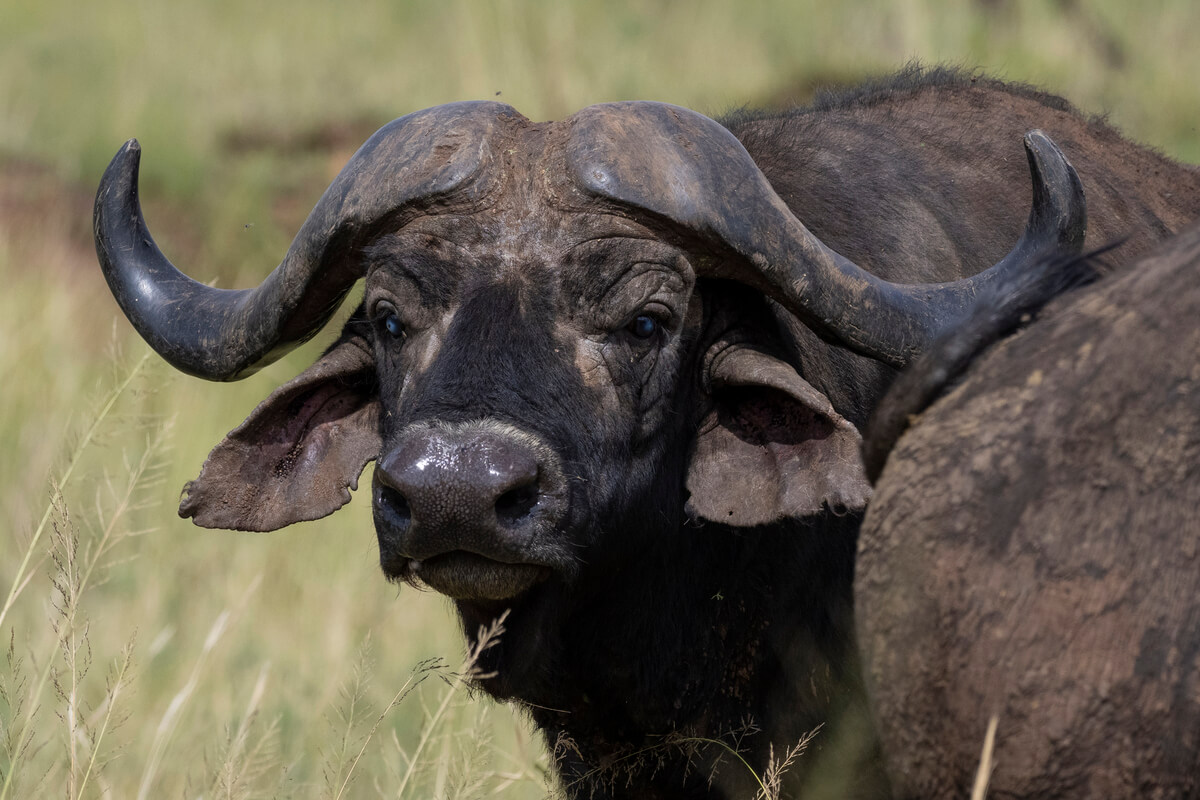

Tips for a Safari in Tanzania and Visiting the Serengeti
Going on a safari in Tanzania and visiting the Serengeti National Park is a very special type of trip. To make the most of it and avoid any unforeseen issues, it’s advisable to follow these tips:
- Malaria in Tanzania: Malaria is present in Tanzania, so it’s important to avoid mosquito bites. Be sure to use insect repellent and wear long, light-colored clothing.
- Sun Protection: Although safaris in Tanzania are done from within a vehicle, the roof is elevated, meaning the sun directly reaches the passengers. Therefore, it’s essential to apply sunscreen before heading out on safaris.
- Binoculars: Bringing binoculars allows you to see animals much better, especially if you don’t have a camera with a good zoom lens.
- Camping Essentials: If you’re staying at public campsites, it’s very useful to bring a flashlight or headlamp.
- Wildlife Observation: The animals in the Serengeti are wild, so animal sightings are never guaranteed. To increase your chances of seeing all the iconic species, it’s worth spending two or three days in this national park.
- No Electricity at Campsites: There is no electricity at the campsites, so bringing a power bank is highly recommended. However, most safari vehicles have charging outlets.
- Kenya vs Tanzania Safari: If you’re unsure between going to Kenya or Tanzania, I recommend reading this post: Kenya or Tanzania Safari: 10 Reasons to Choose.
- Comparing Local Operators: Before booking a safari, it’s crucial to carefully compare reviews and prices from local operators. Joining a group safari is a great way to reduce costs.
- Visa and Travel Info: Before your trip, make sure to review all necessary information about visas, currency, and safety. You can read this Tanzania Trip Guide.



My Experience in Serengeti National Park
I traveled to Tanzania alone, and to do a cheaper safari I decided to book two group safaris with local operators. Obviously, it wasn’t the most practical or optimal route, as I had to travel some fairly slow roads twice. But it allowed me to significantly reduce the cost of safaris in Tanzania.
For the first safari with a local local operator in Tanzania, I paid $1,170, which included six days of safari, airport transfer, one night in a hotel before the safari, and one night in a hotel after the safari. During this safari, I spent two nights in Serengeti National Park, specifically at the Nguchiro Public Campsite.
The second group safari I did was shorter, only four days. To try different agencies, I booked it with another company and it cost me $770. With this safari, I spent one night in the Serengeti, at the Nyani Public Campsite.
So, I ended up enjoying three afternoons and three mornings of safari in the Serengeti. An amazing experience. Below, I’ve written a collection of some of the best moments of my safari in the Serengeti:
1. The Great Migration during my Safari in Tanzania
Although it wasn’t originally planned, the guide on my first safari in Tanzania decided to gift us a tour around Lake Ndutu. In early March, the Great Migration was still there, and we spent a couple of hours searching for the large herds of wildebeest.
It was spectacular to see wildebeest and zebras everywhere, and the drive through Ndutu (just south of the Serengeti) became even more memorable when we found a pride of lions. They were all sleeping with full bellies, probably having hunted the night before.
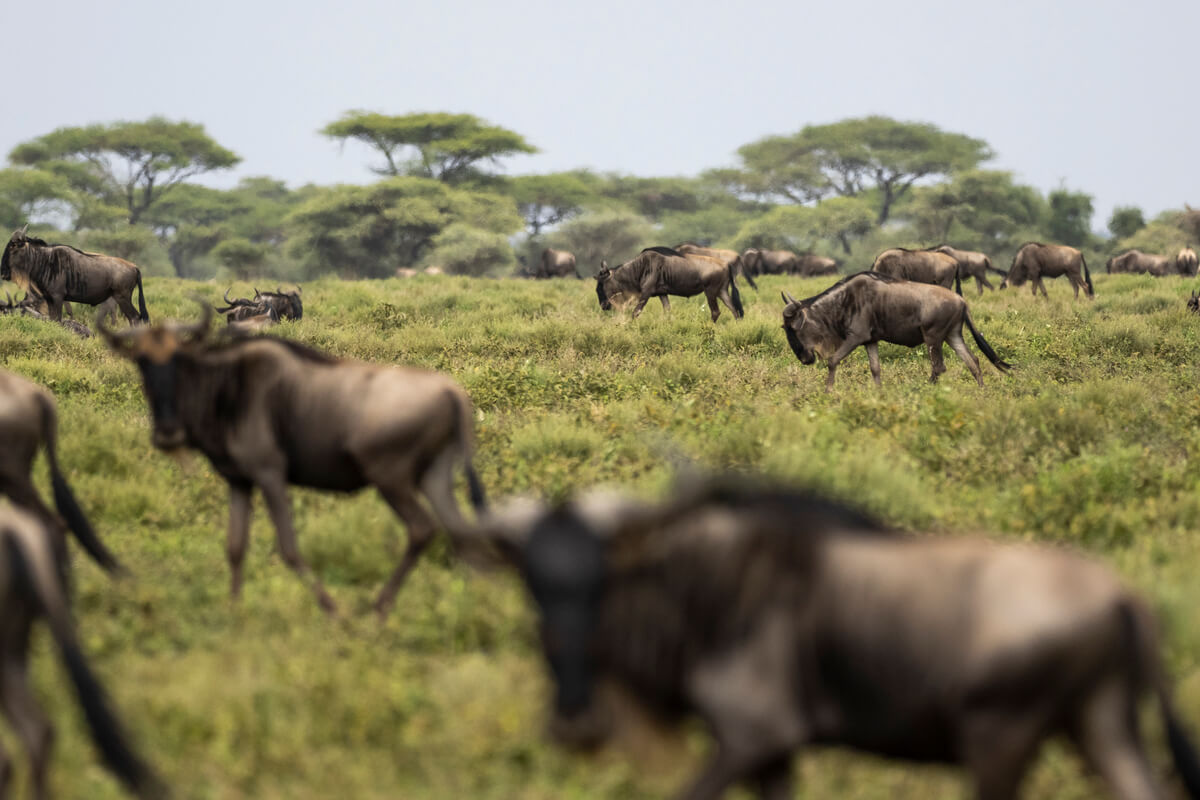



2. A Cheetah in Southern Serengeti
After being amazed by the plains around Lake Ndutu, we began the journey toward central Serengeti. While crossing the savannah of southern Serengeti, we found one of the most common felines in this area of the national park: a cheetah.
The cheetah was patrolling the territory, possibly looking for prey. It was a short but very exciting sighting.

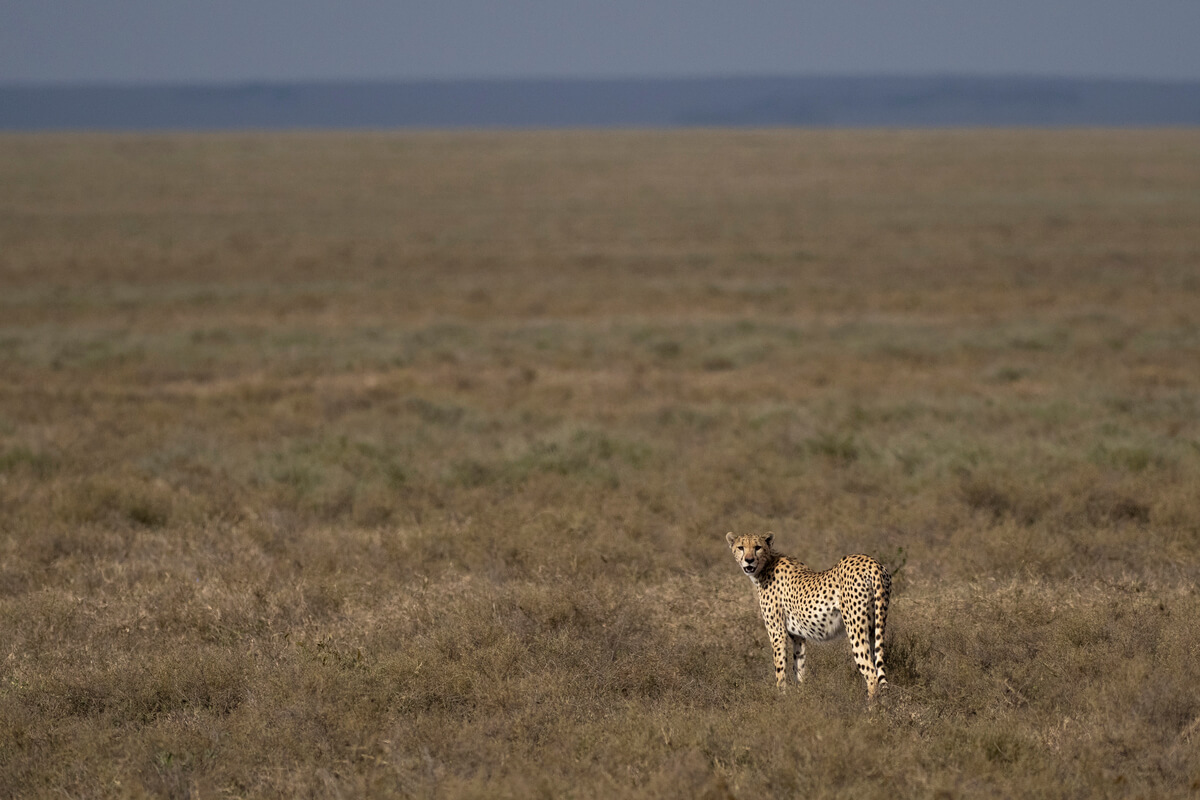
3. A Leopard in the Serengeti Savannah
After our first night in the Serengeti, we started a game drive before sunrise. It was the best time to see some of the savannah predators. We saw a pair of jackals, but not much else.
When the sun started to rise, came the big surprise: a leopard. It was a female, who had just come down from a tree. In fact, only the guide was able to spot her. We managed to get close and see her clearly as she started walking. Like the cheetah, it was a short sighting—just a couple of minutes—but it was enough.

4. A Pair of Lions on Top of a Kopje
In the Seronera region of the Serengeti, which is usually one of the most impressive areas during a safari in Tanzania, there are quite a few kopjes. These rocky hills resemble the landscapes in The Lion King. So every time we passed by a kopje, I closely scanned for any felines resting on the rocks.
Finally, the moment I’d been waiting for arrived. We approached a kopje that was occupied by a pride of lions. At first, we saw a male, half-camouflaged. But as we moved to the other side of the hill, we discovered a dreamlike scene. Right on top of the highest rock sat a male and a female lion.


5. A Group of Giraffes and an Elephant at a Serengeti Campsite
The second night at Nguchiro Campsite, in central Serengeti, was full of surprises. First, when we arrived at the campsite at night, under a light drizzle, we found a group of giraffes feeding near the tents. Walking slowly and avoiding sudden movements, I was able to get quite close and photograph them silently.
However, the most exciting moment came just before going to bed, when an elephant appeared. Without the protection of the car, the experience of being just a few meters from an elephant is completely different. In these cases, it’s important to keep a safe distance and always follow the guides’ instructions.


6. Safari in Tanzania: A Movie-Like Sunrise
During the last morning of the first safari in the Serengeti, elephants were the stars of the show. Just as the sun rose, we found a large group of these massive mammals. There were about thirty of them, walking and feeding with the calm and majesty that define them.
We spent over an hour watching them, with the privilege of having them get closer and closer to the car.




7. A Clash Between Two Hyenas
During the second safari in Tanzania, my stay in the Serengeti was shorter (only one night), but there were still magical moments.
On the first afternoon, we spent quite a while moving across the southern plains, trying to spot a cheetah. We had no luck, but we did witness a very tense moment between two hyenas. One had just hunted a Thomson’s gazelle calf when the other arrived, ready to steal the prey. After a short confrontation, the second hyena managed to snatch the kill and began devouring the small antelope.
A hyena eating a freshly hunted Thomson’s gazelle—a harsh but also very emotional scene to witness during a safari in Tanzania

8. The Serengeti Hippo Pool
In central Serengeti, hippos are also one of the main attractions. In fact, there’s a picnic area known as the Hippo Pools. There, the river water is quite stagnant and usually has many hippos gathered together.
Getting close to that riverside viewpoint is a full visual, auditory, and olfactory experience.


Plan Your Trip to Tanzania
🦍 Find the best trips and safaris to Tanzania with a local operator here.
✈️ The best flight deals to Tanzania here.
🏨 The best prices for accommodations in Tanzania here.
🚑 Get your travel insurance with a 7% discount here.
💳 The best card for paying (without fees) and withdrawing money abroad here.

